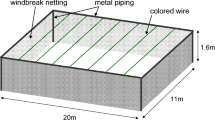Abstract
Many techniques are used to deter birds from damaging crops, but almost all methods are impractical. Line techniques have some effectiveness and rarely result in habituation, but their mechanisms are not clear. Cost-effective and long-lasting damage control approaches are increasingly important, and thus an improved line technique that does not incur higher cost or additional labor is needed. To achieve this, this study used different colored lines (i.e., metallic wire-line and matte black wire-line) to test whether line color affects the deterrence of crows (Corvus spp.). The two colors differ in their ability to reflect the sun. Crows exhibited a higher risk of collision with the matte black wire-lines. Deterrence was also higher with matte black lines than metallic lines. Given these results, the author hypothesizes that lower visibility lines incur higher collision risk and thus have a greater deterrence effect on crows.



Similar content being viewed by others
References
Aguero DA, Hohnson RJ, Eskridge KM (1991) Monofilament lines repel house sparrows from feeding sites. Wildl Soc Bull 19:416–422
Belant JL, Woronecki PP, Dolbeer RA, Seamans TW (1998) Ineffectiveness of five commercial deterrents for nesting starlings. Wildl Soc Bull 26:264–268
Blackwell BF, Bernhardt GE, Dolbeer RA (2002) Lasers as nonlethal avian repellents. J Wildl Manag 66:250–258
Blokpoel H, Tessier GD (1984) Overhead wires and monofilament lines exclude ring-billed gulls from public places. Wildl Soc Bull 12:55–58
Bomford M, O’Brien PH (1990) Sonic deterrents in animal damage control: a review of device tests and effectiveness. Wildl Soc Bull 18:411–422
Brazil M (2009) Birds of East Asia—China, Taiwan, Korea, Japan and Russia. Princeton University Press, Oxford
Conover MR (1982) Behavioral techniques to reduce bird damage to blueberries: methiocarb and a hawk-kite predator model. Wildl Soc Bull 10:211–216
Conover MR (2002) Resolving human–wildlife conflicts—the science of wildlife damage management. CRC, New York
Dolbeer RA, Link MA, Woronecki PP (1988) Naphthalene shows no repellency for starlings. Wildl Soc Bull 16:62–64
Fuller-Perrine LD, Tobin ME (1993) A method for applying and removing bird-exclusion netting in commercial vineyards. Wildl Soc Bull 21:47–51
Gorenzel WP, Blackwell BF, Simmons GD, Salmon TP, Dolbeer RA (2002) Evaluation of lasers to disperse American crows, Corvus brachyrhynchos, from urban night roosts. Int J Pest Manage 48:327–331
Inukai T, Kanno J, Haga T (1952) Studies on the damage done by the crow in Hokkaido and methods of destruction. Bull Agric Hokkaido Univ 1:194–198 (in Japanese with English summary)
Johnson RJ, Cole PH, Stroup WW (1985) Starling response to three auditory stimuli. J Wildl Manag 49:620–625
Kessler KK, Johnson RJ, Eskridge KM (1994) Monofilament lines and a hoop device for bird management at backyard feeders. Wildl Soc Bull 22:461–470
McNamara K, O’Kiely P, Whelan J, Forristal PD, Lenehan JJ (2002) Preventing bird damage to wrapped baled silage during short- and long-term storage. Wildl Soc Bull 30:809–815
Pochop PA, Johnson RJ, Aguero DA, Eskridge KM (1990) The status of lines in bird damage control—a review. In: Proceedings of the 14th Vertebrate Pest Conference, pp 317–324
Sugita S (2004) Karasu–omoshiroseitai to kashikoi husegikata. Noubunkyo, Tokyo
Tracey J, Bomford M, Hart Q, Saunders G, Sinclair R (2007) Managing bird damage to fruit and other horticultural crops. Bureau of Rural Sciences, Canberra
Woronecki PP (1988) Effect of ultrasonic, visual, and sonic devices on pigeon numbers in a vacant building. In: Proceedings of the 13th Vertebrate Pest Conference, pp 266–272
Acknowledgments
The author thanks Dr. J. Tsuboi, S. Yamasaki, H. Yoshida, and Y. Koshimizu.
Author information
Authors and Affiliations
Corresponding author
About this article
Cite this article
Honda, T. Line color affects the collision risk and deterrence of crows. J Ethol 30, 11–14 (2012). https://doi.org/10.1007/s10164-011-0283-z
Received:
Accepted:
Published:
Issue Date:
DOI: https://doi.org/10.1007/s10164-011-0283-z




